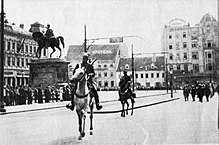1918 protest in Zagreb
Rudolf Sentmartoni On 5 December 1918, four days after the proclamation of the Kingdom of Serbs, Croats and Slovenes, the National Guards (an armed force of the National Council of the State of Slovenes, Croats and Serbs) and Sokol volunteers suppressed a protest and engaged in an armed clash against the soldiers of the 25th Regiment of the Royal Croatian Home Guard and the 53rd Regiment of the former Austro-Hungarian Common Army.
Reasons for the protest and the conflict are not very well documented, but the soldiers who marched down Ilica Street from the Rudolf barracks towards the central city square shouted slogans against the King Peter I of Serbia and in support of republicanism and the Croatian People's Peasant Party leader Stjepan Radić.
Thus the "culture of defeat" contributed to the rise of Ustaše as far-right paramilitaries and later Nazi collaborators during the World War II occupation of Yugoslavia.
[2] National Council president Anton Korošec left Zagreb for a conference in Geneva with Serbian representatives to discuss the method of unification.
[7] The National Council hesitated to condemn the violence,[6] and its attempts to stop the looters by deploying ad-hoc, locally raised militia were ineffective since many militiamen were also looting.
[12] The peasants actively involved in the October–November unrest, misidentifying republicanism as the abolition of military service and taxes, cited it as their ultimate political objective.
While Ante Trumbić's Yugoslav Committee advocated a federal system of government, the Prime Minister of Serbia Nikola Pašić wanted a centralised state.
[14] Pašić threatened to conquer and annex the Serb-inhabited territories of Austria-Hungary to create a Greater Serbia unless Trumbić accepted a centralised state.
[18] Shortly after the conclusion of the Geneva conference, the National Council announced it had thwarted an attempted coup d'état for which it arrested General of the Infantry Anton Lipošćak.
[21] The National Council dispatched a delegation to Prince Regent Alexander to quickly arrange unification of Yugoslavia on a federal basis.
The Prince Regent accepted the unification offer on behalf of Peter I of Serbia,[22] and the Kingdom of Serbs, Croats and Slovenes was established without any agreement on the nature of the union.
Nonetheless, many soldiers based in Zagreb supported a republic; republican ideas spread under the influence of Radić and returnees from Russia in the aftermath of the October Revolution.
[37] Kućak and Petrović informed the deputy defence commissioner of the National Council Nikola Winterhalter of the pro-republican mood in the troops stationed in Zagreb barracks.
[39] In the morning of 5 December, Zagreb Cathedral held a Te Deum service as a part of celebration of establishment of the Kingdom of Serbs, Croats and Slovenes.
[28] In the afternoon of 5 December, some soldiers of the 53rd Regiment left the Rudolf barracks in western Zagreb and set out towards Ban Jelačić Square.
[42] Protesting the unification with Serbia,[36] the soldiers walked down Ilica Street carrying a flag of Croatia and shouting "Long live the republic!
Gabelica also argues that the protest was in part spurred on by various causes for discontent such as widespread poverty and anarchy in the country as well as by external actors such as by Italian intelligence services.
[50] Armed National Guardsmen and Sokol volunteers were waiting for the soldiers and civilians who joined the protest, taking cover in the surrounding buildings.
[58][59] In his 1947 testimony, Kvaternik said the National Guards had a machine gun on the south side of the square at the house number 27 at the corner of present-day Praška Street, but no other source supports that claim.
The deaths included two National Guardsmen (both Sokol members), an unidentified Serbian soldier whom Simović says was not an active participant in the clash,[60] and two civilians.
[65] The National Council disbanded the 25th and the 53rd regiments on the evening of 5 December,[26] and cited the clash and the Lipošćak affair as grounds to restrict the inclusion of Croatian officers who previously served in the Austro-Hungarian armed forces in new army as unreliable.
The soldiers of the 25th and the 53rd regiments who died on the Ban Jelačić Square became referred to as the December Victims, and portrayed as martyrs for independence of Croatia.
This allowed the Frankist leaders in 1920s, notably Ante Pavelić, to offer disgruntled people and forgotten former Austro-Hungarian officers a chance to "redeem" themselves as far-right Ustaše paramilitaries (and later Nazi collaborators).
[72] In 1932, the Croatian Woman Society launched an initiative to transfer bodies of the killed soldiers and civilians (not the National Guardsmen) from their individual graves at the Mirogoj to a common crypt.
[73] On 26 August 1941, Pavelić declared "600 revolutionaries" involved in the 5 December 1918 protest a Reserve Battalion of the Ustaše Militia, originally a ceremonial unit.
[80] A plaque was placed by Croatian World War II veterans association Hrvatski domobran [hr] on the former House Feller (now number 11) in 2003 to commemorate the 1918 protest.




